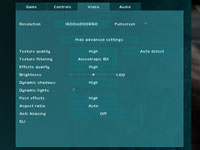For gameplay evaluations on a CRT, please head back to our CRT performance section.
We used the latest addition to Tom Clancy's Ghost Recon series - Ghost Recon Advanced Warfighter and patched the game to version 1.10. This has to be one of the best-looking games on the market at the moment, even despite its lack of support for anti-aliasing on any of today's current hardware. The game makes use of High Dynamic Range lighting and a whole plethora of special effects. Probably the biggest talking point for Ghost Recon Advanced Warfighter is its support for AGEIA's PhysX PPU.
The lack of support for anti-aliasing may seem like a backwards step in image quality, as there are many areas of the game that could certainly benefit from a multisample anti-aliasing pattern. The lack of anti-aliasing support is due to the fact that the game uses multiple render targets to achieve some of the advanced graphical effects. This is due to the way that the DirectX 9.0 specification was set out, and even if multiple render targets and anti-aliasing could work in harmony, it'd be incredibly costly because every surface in the multiple render target would need to be sampled.
We did a five minute manual run through from the start of the Strong Point level. This incorporates lots of post processing effects, HDR lighting, explosions, gun fire and water, too in order to give the graphics subsystem a good work out. The game has no support for anti-aliasing, but anisotropic filtering was controlled from inside the game.

 As was the case in our CRT evaluations, the GeForce 7950 GX2 delivered the best gaming experience in GRAW. We were able to keep maximum in-game settings enabled, including the edge smoothing option that GRIN refers to as 'anti-aliasing'. The experience was immersive and impressive at the same time. Although edge smoothing didn't get rid of all edge aliasing, it did remove some of it. In particular, the edge smoothing algorithm helped to smooth out power lines, but it didn't seem to help remove harsh aliasing from railings and barriers.
As was the case in our CRT evaluations, the GeForce 7950 GX2 delivered the best gaming experience in GRAW. We were able to keep maximum in-game settings enabled, including the edge smoothing option that GRIN refers to as 'anti-aliasing'. The experience was immersive and impressive at the same time. Although edge smoothing didn't get rid of all edge aliasing, it did remove some of it. In particular, the edge smoothing algorithm helped to smooth out power lines, but it didn't seem to help remove harsh aliasing from railings and barriers.
The Radeon X1950XTX was the next-best performer, and we were reasonably impressed by the experience that it delivered. We had to lower the quality settings slightly, in order to attain smooth frame rates, but with post effects set to medium, the gameplay was very smooth. Edge smoothing slowed things down a lot, so we felt that it was better just to put up with the aliasing. It's a shame, because it spoils a game that would otherwise be the best looking game on the market.
Ghost Recon Advanced Warfighter:
Publisher: UbisoftWe used the latest addition to Tom Clancy's Ghost Recon series - Ghost Recon Advanced Warfighter and patched the game to version 1.10. This has to be one of the best-looking games on the market at the moment, even despite its lack of support for anti-aliasing on any of today's current hardware. The game makes use of High Dynamic Range lighting and a whole plethora of special effects. Probably the biggest talking point for Ghost Recon Advanced Warfighter is its support for AGEIA's PhysX PPU.
The lack of support for anti-aliasing may seem like a backwards step in image quality, as there are many areas of the game that could certainly benefit from a multisample anti-aliasing pattern. The lack of anti-aliasing support is due to the fact that the game uses multiple render targets to achieve some of the advanced graphical effects. This is due to the way that the DirectX 9.0 specification was set out, and even if multiple render targets and anti-aliasing could work in harmony, it'd be incredibly costly because every surface in the multiple render target would need to be sampled.
We did a five minute manual run through from the start of the Strong Point level. This incorporates lots of post processing effects, HDR lighting, explosions, gun fire and water, too in order to give the graphics subsystem a good work out. The game has no support for anti-aliasing, but anisotropic filtering was controlled from inside the game.


The Radeon X1950XTX was the next-best performer, and we were reasonably impressed by the experience that it delivered. We had to lower the quality settings slightly, in order to attain smooth frame rates, but with post effects set to medium, the gameplay was very smooth. Edge smoothing slowed things down a lot, so we felt that it was better just to put up with the aliasing. It's a shame, because it spoils a game that would otherwise be the best looking game on the market.

MSI MPG Velox 100R Chassis Review
October 14 2021 | 15:04










Want to comment? Please log in.